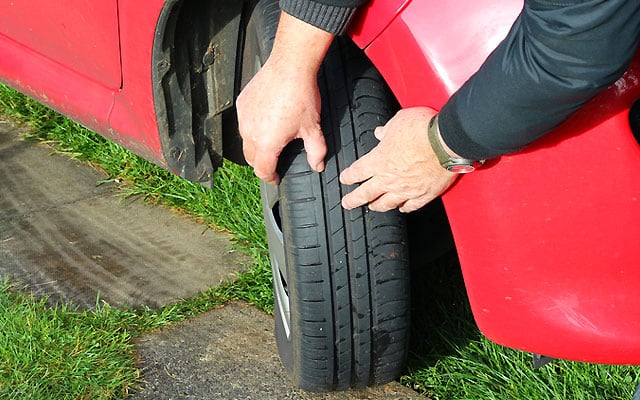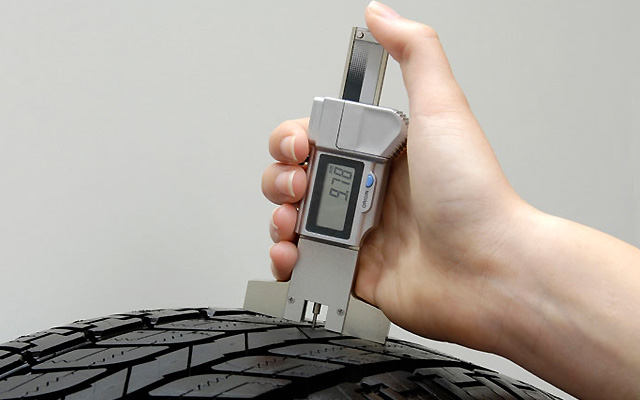It's the law to make sure your tyres have a minimum tyre tread depth. Find out what the legal limit is for tyres, and learn how to check your tyre tread here.
What is tyre tread?
Tyre tread is the rubber part of the tyre that makes contact with the road surface – it’s located all around the circumference of the tyre. As tyres are used, the tread slowly wears off, reducing the traction between them and the road.
- New tyres start with about 8 mm of tread depth
- Once they wear down to 4 or 5 mm, you should check the tread monthly
- You should consider replacing them at 3 mm
- The minimum legal tread depth for cars is 1.6 mm
It's important to keep your tyres well maintained, and check the tread often. This will help you with your braking distance.
Checking tyre tread depth
The best way to test your tyres is to use a calibrated tyre gauge. These come in many different forms – from digital gauges, to laminated cards with coloured indicators.
- To use, place the gauge into the tyre’s groove.
- The gauge will show you how close you are to reaching the required minimum depth for your vehicle.
- Check the tyre tread regularly and at different places across the tyre, so you can watch out for worn tyres and spot any early signs of uneven wear.
Tips and tricks
The 20p test
If you don’t have a gauge, you can test your tyres with a 20p coin, as its outer rim is just under 3 mm wide.
- Place a 20p coin into your tyre’s tread grooves.
- If the outer rim of the coin is obscured, it means your tyre is comfortably above the legal minimum tread depth.
- If you can see part of the rim of the coin then it's time to check your tyres more carefully using a proper tyre tread depth gauge.

Tread wear indicators
You can also look out for tread wear indicators to check if your tyre tread is legal. These are usually small bars, about 5 mm wide, built into the base of the tyre's main grooves.
- If the tyre tread is level with the top of the wear indicator, it means your tyres have reached the legal limit of 1.6 mm.
- When tyres are worn to this level, they need to be replaced.
Why check tread depth?
Driving on tyres with tread below the legal limit can be incredibly dangerous, as well as illegal. It’s even worse driving with bald tyres, where the tread has worn away altogether.
Hazards of driving with worn tyres include:
- Less grip on wet roads.
- Longer stopping distances.
- A greater risk of aquaplaning.
- Less traction on icy roads or snow.
- More chance of punctures, which can lead to a sudden blowout.
If you change your tyres when the tread wears down, you’ll have better grip on the roads and less stopping distance. You’ll also save fuel, as it’s more efficient to drive on an intact tyre tread.
Worn tyres or flat spots may also cause your steering wheel to shake or vibrate.
What are the legal requirements?
What's the legal minimum depth of tread for tyres?
The legal minimum varies by each type of vehicle.
What makes tyres illegal?
Tyres that are illegal for road use include:
- Having a low tyre tread (below 1.6 mm). These are ‘bald tyres’, where the rubber has been completely worn off
- Cracked, slashed, scratched or bulging tyres
- Under or over-inflated tyres
- Tyres that are too small or too large for your vehicle (and are therefore unable to handle the required load or meet speed requirements)
What if I get into an accident with illegal or dangerous tyres?
If you’re involved in an accident and your tyres don’t meet the legal minimum standards, any insurance claim you make could be invalidated.
If you drive with tyres that are dangerous because they’re worn or bald, you could be prosecuted for using a vehicle in a dangerous condition.
It could get you a fine of up to £2,500 and 3 points on your licence. And that’s just per tyre. If all 4 tyres are found to be dangerous, you could be looking at a £10,000 fine and 12 points.
Other legal tyre requirements
Because they play such a vital role, there are 2 specific requirements for legal tyres:
1. Tyres must be fit for purpose and be free from any defects which might damage the road or endanger any person.
To be ‘fit for purpose’, tyres must not have:
- Any lumps, bumps or bulges, as these can mean structural damage.
- A cut or tear bigger than 25 mm or 10% of the width of the tyre, whichever is greater, and which is deep enough to reach the ply or cord.
- Any part of the ply or cord exposed.
2. Tyres must be inflated to the right pressure. That means sticking to the pressure recommended by both your vehicle manufacture and the tyre manufacturer.
When should I change my tyres?
Check your tyre tread depth more often once they get down to 3 mm. Aim to replace tyres before the tread wears below 2 mm.

Changing your tyres is more important as autumn and winter approach. It’s better to get new tyres before winter than struggle through the cold and wet with tyres approaching the legal minimum tread depth.
How long will 2 mm tyre tread last?
You can expect around 1,000 miles out of your tyres if they’re down to 2 mm of tread. City driving is likely to wear tyres down quicker than motorway driving.
How long will 5 mm tyre tread last?
You can expect to get around 20,000 miles out of 5 mm of tyre tread – but make sure to check the health of your tyres regularly throughout.
Last updated: 29 October 2024 | Author: The AA
